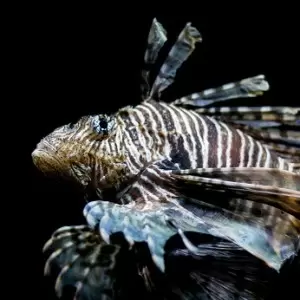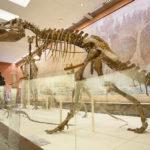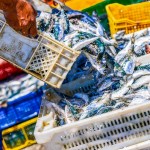
One consequence of globalization is that in addition to people and products moving across the globe, wildlife has been transported as well. This practice of transporting animals from their native regions to new areas dates back thousands of years. The Roman Empire frequently brought back animals from foreign lands to use for entertainment in the Colosseum or used them for military purposes.1 The practice was also a common part of European explorations of the New World, as explorers would bring back novel specimens to their home countries for zoological examinations or to arouse interest in future expeditions.
In many cases, the transplanted animal or plant does not thrive in its new environment. A lack of proper food sources combined with the wrong climate can make for a short lifespan for the animal in its new home. In other cases, however, the specimen thrives and is able to successfully reproduce and spread throughout its new habitat. When this happens, the plant or animal can wreak havoc on the new area and become an invasive species.
What Makes a Species Invasive?
Introducing a species into a new environment may have a variety of outcomes. An exotic or alien species is one that has been introduced to a new place, but does not necessarily have negative consequences. For example, many fish species have been introduced into the Great Lakes for sport fishing.2 They have no documented negative impacts and provide recreational opportunities and a food source. However, when these alien species begin to have negative consequences in the new habitat, they are called invasive species. Invasive species may cause environmental harm, economic harm, or impact human health.
A key factor that makes many species invasive is a lack of predators in the new environment.3 This is complex and results from thousands of years of evolution in a different place. Predators and prey often co-evolve in a phenomenon called the co-evolutionary arms race. What this means is that as prey evolve better defenses, predators in turn evolve better ways of exploiting prey. The classic example of this comes from the cheetah and antelope. Faster antelope survive better because they can better escape cheetahs. The fastest cheetahs then survive better because they can better catch the faster antelope. Neither species ultimately gains an advantage because they continually evolve in response to one another.
However, when a plant or animal enters a new environment, they will likely encounter predators who have not been evolving with them, which makes these predators unable to successfully exploit the prey. Defense mechanisms like venom, size or speed that have been matched by adaptation in predators are suddenly without match in the new environment. This can allow the species to proliferate rapidly as it no longer faces any predators.2 Many insect or fungi that are invasive in the United States come from regions where native trees have evolved resistance to their effects. When these species enter the US, they find trees that have no resistance and they can decimate forests quickly.
Invasive species may also be able to exploit a resource that native species cannot use, which allows them to take hold in the new environment. Introduced into the Western United States, barbed goatgrass thrives in serpentine soils, whereas native plants do not normally grow in them.4 This has given them a solid stronghold in the area. Combined with the fact that grazing animals do not like the taste of them, the grass has spread rapidly throughout California.
Some species also alter the environment in a manner that makes it more favorable for them, but less favorable for natives, which is called ecological facilitation. Yellow starthistle has also been introduced to the West Coast and secretes the chemical compound 8-hydroxyquinoline from the root.5 This chemical harms native plants, which allows starthistle to increase its range as its chemicals wipe out native competitors.
Where Do Invasive Species Come From?
Invasive species may enter new environments through many routes. Some are transported to new places and established intentionally, but with unforeseen consequences. Beach vitex was planted in coastal North Carolina in the 1980's as an ornamental plant for coastal homes.6 However, the plant began to overtake native species after it became established. The plant also does not have the extensive root system that holds sand in place as native plants do. As it spreads, the plants hasten dune erosion by removing plants that secure the sands of the dunes.
Some invasive species were actually brought in as unsuccessful attempts to control other invasive species. In the 1800's, rats that came to the Virgin Islands on ships infested the sugar cane fields on the islands, causing massive crop damage.7 Farmers brought in mongoose as a predatory control for the rats. However, the rats are nocturnal and sleep in trees, whereas the mongoose are diurnal and cannot climb trees, so they were not successful at eradicating the rats. As a result, the islands now have two invasive species to contend with.
Other species are brought to different places intentionally but released accidentally, as happens sometimes with animals in zoos and aquariums. Lionfish are thought to have been introduced to the Caribbean when several of them escaped from a broken beachfront aquarium during Hurricane Andrew in 1992.8 Sometimes people buy exotic pets and release them when they no longer want to care for them. This has been the case with Burmese pythons that are invasive in the Everglades.9 These were once a popular pet because they are brightly colored and have an easy-going demeanor. However, they can grow up to 6 feet in the first year and live in excess of 20 years. A full-grown Burmese python can be up to 13 feet long and requires a specially-made enclosure and a large amount of food. This quickly becomes too burdensome for many owners, who then release them into the wild. As a result, a large population of these snakes now occupies South Florida.
A large number of invasive species have also been transported incidentally through shipping. The Great Lakes provide a good example of this. For millennia, the Great Lakes remained separated from other major bodies of water. When the St. Lawrence Seaway, a system of canals and dams, was built to connect the Great Lakes to the Atlantic Ocean, this waterway provided a conduit for invasive species to enter the area. This mainly happened through the discharge of ballast water.10 Ballast water is used to weigh down empty ships and then discharged when ships enter a port in order to make weight available for cargo. The water is typically from the previous port where the ship was docked, and often contains living organisms from the area. By discharging ballast water into the Great Lakes when they arrive, ships have introduced more than 56 invasive species into the area.
In the 16th century, Spanish galleons also transported invasive species, but did so through ballast soil.11 They would load the ship down with soil instead of water, but this soil also contained fire ants. As ships stopped at various ports along trade routes, dumping out the soil released fire ants into the areas, which were quickly able to colonize new places.
Many other examples exist of invasive species hitching rides on cargo to enter new habitats. For example, the fungus known as chestnut blight came from chestnut trees that were imported from Japan in the late 19th century.12 The Asian tiger mosquito was introduced accidentally in tires shipped into the United States from Asia.13 Naval shipworms entered the San Francisco Bay on cargo ships in the early 20th century and caused significant damage to piers and harbors.
Once they enter a new place, many different components of the habitat may facilitate their spread. Roads, for example, provide a pathway for invasives to move through new areas. The habitat alongside the road is clear of native vegetation, which makes it easy for fire ants to build mounds in this area.14 When areas are cleared for grazing, the lack of native vegetation means less competition with existing species and can make it easier for invasives to establish themselves.
What Are the Consequences of Invasive Species?
Invasive species can have a number of negative impacts on the areas that they invade. Perhaps the most significant of these is the widespread loss of habitat. The hemlock woolly adelgid is an invasive insect from Asia that rapidly kills infested hemlock trees. In some parts of the Eastern United States, it is estimated that up to 80% of hemlock trees have been killed.15 These forests represent important habitat for many animals and with crucial habitat gone, species that rely on them may face extinction. Similarly, the health of many forests is threatened by kudzu vines, introduced from Japan in the 19th century as an ornamental plant.16 This plant was widely distributed across the Southeastern United States as a means of erosion control and as a food source for grazing animals. The vine soon became invasive, however, and can completely overgrow entire forests. In the process, it prevents sunlight from reaching the trees, effectively killing the forest. Additionally, the weight of the thick mats of vines on trees can cause trees to break and fall over. Its ability to quickly overgrow and destroy forests has earned it the nickname “the vine that ate the South.”
Some invaders can physically alter the habitat in addition to destruction. 50 beavers from Canada were relocated to Tierra del Fuego, an archipelago at the southern tip of South America, in 1946 to be hunted for their pelts.17 Since then, they have multiplied and now number in the hundreds of thousands. The trees in the region are not adapted to beaver activity as they are in North America, and most do not grow back after being gnawed by beavers. Portions of the formerly pristine forests now look like a bulldozer has plowed through them. Additionally, beaver activity creates ponds that flood portions of the forest. These bodies of stagnant water alter the nutrient cycle in forests and invasive plants thrive in them. Beavers also build dams in drainage ditches of grasslands and livestock commonly fall into them, where they become stuck and die.
Other invasive species may not destroy habitat but can have an impact by killing large numbers of endemic species. Burmese pythons, for example, are top predators in the Everglades. As such, they have decimated local mammal and bird populations.18 Capable of consuming deer and even alligators, these creatures eat virtually any animal they encounter in the Everglades. A number of threatened and endangered bird species have also been found in the digestive tracts of pythons, prompting concern that they could drive some species toward extinction.19 Lampreys in the Great Lake parasitize native fish. Because the native species have not evolved defenses to lampreys, they often die outright from wounds, or wounds become infected and eventually cause mortality.20 Invasives can also threaten native species by outcompeting them for resources. Asian carp introduced into the United States outcompete native fish for both food and space, leading to large declines in native fish populations.21 Invasive species are the second largest cause of species extinctions in the United States.22
Invasive species can also impact human health. Invasive zebra mussels accumulate toxins in their tissues like PCB's and PAH's. When other organisms prey on these mussels, the toxins are passed up the food chain and can also enter animals consumed by humans.23 Ballast water from ships also sometimes contains harmful bacteria like cholera. Invasive animals can also be vectors for disease.
In addition to these impacts, invasive species can also have enormous economic costs. Zebra mussels in the Great Lakes can rapidly cover submerged surfaces, clogging up water intakes at water treatment facilities and power plants. Removing this invasive species costs an estimated $500 million annually in the Great Lakes alone.24 Power companies spend an estimated $1.5 million each year to control kudzu vines growing on power lines.16 Lampreys in the Great Lakes have decimated many fishery stocks to the point that they are no longer profitable.20 In the United States, invasive species cost an estimated $120 billion annually in control methods and in loss of environmental resources.22
What Can Be Done to Deter Invasive Species for Specific Habitats?
Many strategies have been developed to stop the damage caused by invasive species and to prevention future invasions. An important component is educating people about the dangers of transporting wildlife to new areas. Many laws and regulations have also been passed to combat the future spread of invasives. Ballast water in tankers is required to be decontaminated before it can be released from the boat.10 Laws have also been passed to restrict the exotic pet trade, such as banning the import of Burmese pythons in the United States.25
Promoting the harvest of invasive species is another widely used technique, although it has been employed with limited success. A python hunt in Florida in 2013 provided cash awards to people for killing pythons.9 In Argentina, officials have tried to promote a market for beaver pelts and hunters were encouraged to hunt them.17 People have also used the woody vines of kudzu to craft baskets and other items. A problem encountered with this strategy is that often the demand is not nearly high enough to make a discernible impact on invasive populations. In the case of pythons, they are extremely secretive and elusive, which makes them difficult to find them for eradication.
As with many environmental problems, continued research will yield insight into effective control measures. For example, research studies have been conducted to determine how effective traps are in catching pythons.26 Genetic studies can also yield important information about how invasives have spread in an area and their potential to hybridize with native species.27 Predicting how the geographic range of an invasive species will increase is important for preparing new areas that may be invaded. Much research has also been devoted to determining the most effective ways of removing invasive plants, whether through herbicides or through mechanical destruction of the plants. Using chemicals to kill sea lampreys in the Great Lakes during their vulnerable larval stages has been shown to effectively kill them without harming other wildlife.20 While many invasive species may not ever by fully eradicated, increased awareness and research offer methods of preventing their spread and controlling the economic and environmental damage they can incur.
Sources
- http://www.iridescent-publishing.com/rtm/ch1p1.htm
- https://www.invasivespeciesinfo.gov/terrestrial/plants/yellow-star-thistle
- https://www.invasivespeciesinfo.gov/terrestrial/plants/beach-vitex
- http://stthomassource.com/content/news/local-news/2006/03/05/mongoose-dem-trouble-territory
- http://www.anstaskforce.gov/spoc/lionfish.php
- http://www.washingtonpost.com/national/health-science/big-but-nearly-invisible-in-the-wild-officials-give-up-on-evicting-pythons-from-everglades/2014/03/16/58cab268-aa37-11e3-8599-ce7295b6851c_story.html
- http://www.jsonline.com/news/wisconsin/how-invasive-species-changed-the-great-lakes-forever-b99297128z1-267010971.html
- http://www.livescience.com/49866-how-fire-ants-spread-around-globe.html
- http://www.ct.gov/caes/cwp/view.asp?a=2815&q=376754
- https://www.invasivespeciesinfo.gov/terrestrial/invertebrates/asian-tiger-mosquito
- http://www2.ca.uky.edu/caps/hwa_hot_topic.asp
- http://www.scientificamerican.com/article/argentina-and-chile-decide-not-to-leave-it-to-beavers/
- http://www.glfc.org/sea-lamprey.php
- http://www.nwf.org/wildlife/threats-to-wildlife/invasive-species/asian-carp.aspx
- http://www.anstaskforce.gov/ans.php
- http://www.copper.org/about/pressreleases/2009/pr2009_July_30.html
- https://www.usnews.com/news/articles/2014/07/21/invasive-pythons-threaten-florida-everglades
- Invasive Species: How They Affect the Environment - February 23, 2015
- Birds in a Changing Climate - February 11, 2015
- Environmental Consequences of Fishing Practices - February 6, 2015
Related Articles
Featured Article

Microbiology: Tiniest Lifeforms Under the Microscope





